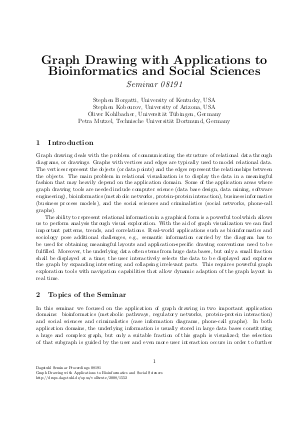08191 Executive Summary – Graph Drawing with Applications to Bioinformatics and Social Sciences
Authors Stephen Borgatti, Stephen Kobourov, Oliver Kohlbacher, Petra Mutzel
-
Part of:
Volume:
Dagstuhl Seminar Proceedings, Volume 8191
Part of: Series: Dagstuhl Seminar Proceedings (DagSemProc) - License:
 Creative Commons Attribution 4.0 International license
Creative Commons Attribution 4.0 International license
- Publication Date: 2008-07-22
File

PDF
DagSemProc.08191.2.pdf
- Filesize: 71 kB
- 3 pages
Document Identifiers
Subject Classification
Keywords
- Graph drawing
- visualization
- social sciences
- bioinformatics
Metrics
- Access Statistics
-
Total Accesses (updated on a weekly basis)
0PDF Downloads0Metadata Views
Abstract
Graph drawing deals with the problem of communicating the structure of relational data through diagrams, or drawings. The ability to represent relational information in a graphical form is a powerful tool which allows to perform analysis through visual exploration to find important patterns, trends, and correlations. Real-world applications such as bioinformatics and sociology pose challenges to the relational visualization because, e.g., semantic information carried by the diagram has to be used for obtaining meaningful layouts and application-specific drawing conventions need to be fulfilled. Moreover, the underlying data often stems from huge data bases, but only a small fraction shall be displayed at a time; the user interactively selects the data to be displayed and explores the graph by expanding interesting and collapsing irrelevant parts. This requires powerful graph exploration tools with navigation capabilities that allow dynamic adaption of the graph layout in real time. In this seminar we focused on the application of graph drawing in two important application domains: bioinformatics and social sciences. We brought together theoreticians and practitioners from these areas and focused on problems concerning interaction with and navigation in large and dynamic networks arising in these application areas; During the seminar, we identified and defined open graph drawing problems that are motivated by practical applications in the targeted application areas, tackled selected open problems, formulated the findings as a first step to the solution, and defined further research directions.
Cite As Get BibTex
Stephen Borgatti, Stephen Kobourov, Oliver Kohlbacher, and Petra Mutzel. 08191 Executive Summary – Graph Drawing with Applications to Bioinformatics and Social Sciences. In Graph Drawing with Applications to Bioinformatics and Social Sciences. Dagstuhl Seminar Proceedings, Volume 8191, pp. 1-3, Schloss Dagstuhl – Leibniz-Zentrum für Informatik (2008)
https://doi.org/10.4230/DagSemProc.08191.2
BibTex
@InProceedings{borgatti_et_al:DagSemProc.08191.2,
author = {Borgatti, Stephen and Kobourov, Stephen and Kohlbacher, Oliver and Mutzel, Petra},
title = {{08191 Executive Summary – Graph Drawing with Applications to Bioinformatics and Social Sciences}},
booktitle = {Graph Drawing with Applications to Bioinformatics and Social Sciences},
pages = {1--3},
series = {Dagstuhl Seminar Proceedings (DagSemProc)},
ISSN = {1862-4405},
year = {2008},
volume = {8191},
editor = {Stephen P. Borgatti and Stephen Kobourov and Oliver Kohlbacher and Petra Mutzel},
publisher = {Schloss Dagstuhl -- Leibniz-Zentrum f{\"u}r Informatik},
address = {Dagstuhl, Germany},
URL = {https://drops.dagstuhl.de/entities/document/10.4230/DagSemProc.08191.2},
URN = {urn:nbn:de:0030-drops-15523},
doi = {10.4230/DagSemProc.08191.2},
annote = {Keywords: Graph drawing, visualization, social sciences, bioinformatics}
}
